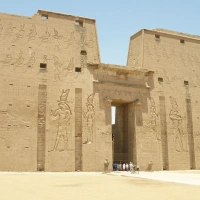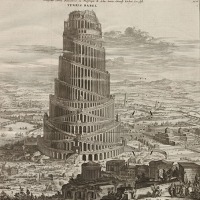One of the hardest, most durable substances around today is concrete. But today’s concrete only lasts a few decades before it starts to crack and crumble.
However, did you realize that Roman concrete has lasted for 2,000 years? The Romans used concrete to build roads, buildings, aqueducts, bridges, and seawalls for harbors. Many of these structures still exist today, and some are still in use.
One example is the ancient Roman concrete aqueducts which today still deliver water to Rome. Another is the Pantheon in Rome which has the largest unreinforced concrete dome in the world. The Pantheon was dedicated around A.D. 126, and the dome remains intact.
Europe, Africa, and the Mideast have at least 961 Roman bridges, mostly of stone and concrete, in at least 26 countries. Many are still in use and carry vehicles. For example, the Pons Fabricius is the oldest Roman bridge in Rome that still exists in its original state. It was built in 62 BC to span the Tiber River. It is 18 feet wide and 200 feet long.
The Puente Romano (Spanish for Roman Bridge) is a Roman bridge over the Guadiana River in Mérida, Spain. It is the world’s longest surviving bridge from ancient times. It was built around 100 AD and is about 23 feet wide and 2500 feet long. It carried vehicles until 1991 when road traffic was redirected to another bridge and it was reserved for pedestrians.
The Roman road system comprised 250,000 miles of roads, including 50,000 miles of paved roads. The road system covered western Europe, advanced well into Britain, and extended throughout Spain, northern Africa, and the Middle East.
Zippori (Hebrew) or Sepphoris (Roman) was the capital of Galilee under Herod and the Romans in the first century AD. It was substantially destroyed by Roman soldiers in 4 BC and rebuilt during the lifetime of Jesus. Here is a picture of a Roman road excavated at Sephoris, Israel.
What was the ancient Roman secret for making highly durable concrete that has lasted for thousands of years?
Last year researchers from MIT, Harvard, and labs in Italy and Switzerland discovered a possible answer. In a research paper published in the journal Science Advances, they said the secret to the longevity of Roman concrete was millimeter-sized bits of limestone in the mix. (A millimeter is about 0.04 inches, about the thickness of a plastic credit card.)
(See Hot mixing: Mechanistic insights into the durability of ancient Roman concrete, Science Advances, 6 Jan 2023, Vol 9, Issue 1)
Roman concrete makers mixed in tiny limestone bits at very high temperatures. This gave the concrete a “self-healing” property. As soon as cracks start to form, the “cooked” limestone bits reacted with water to recrystallize to fill the cracks, react with the cement, and strengthen the concrete.
The team of researchers cracked samples of concrete they made like they hypothesized the ancient Romans had made it. Then they ran water through it. In two weeks the cracks completely healed. The team is now working to commercialize the process.
The Narrow Road
Today concrete is commonly used for roads and sidewalks — in other words, for pathways for people to get somewhere.
Jesus of Nazareth spoke of roads and pathways. In fact, He made a quite surprising statement about roads. He said the most important road is hard to find.
“Enter through the narrow gate; for the gate is wide and the way is broad that leads to destruction, and there are many who enter through it. For the gate is small and the way is narrow that leads to life, and there are few who find it.” (Matthew 7:13-14)
However, there is a still-existent Roman Road that will help you find this most important road that leads to eternal life. It is a “road” through the Gospel using verses from the book of Romans to walk through the Good News of salvation from sin and death through faith in Jesus Christ.
- Romans 3:23 – For all have sinned and fallen short of the glory of God.
Everyone is a sinner. - Romans 6:23 – For the wages of sin is death, but the free gift of God is eternal life in Christ Jesus our Lord.
The penalty for sin is death, but God offers eternal life instead, as a free gift through Jesus. - Romans 5:8 – But God demonstrates His own love toward us, in that while we were yet sinners, Christ died for us.
Jesus died to pay the penalty for people’s sin. - Romans 10:9-10, 13 – If you confess with your mouth Jesus as Lord, and believe in your heart that God raised Him from the dead, you will be saved; for with the heart a person believes, resulting in righteousness, and with the mouth he confesses, resulting in salvation. … For whoever will call on the name of the Lord will be saved.
Believe in Jesus and His resurrection. Verbalize your allegiance to His Lordship, and you will be saved. - Romans 5:1; Romans 8:1; Romans 8:38-39 –
Therefore, having been justified by faith, we have peace with God through our Lord Jesus Christ.
Therefore there is now no condemnation for those who are in Christ Jesus.
For I am convinced that neither death, nor life, nor angels, nor principalities, nor things present, nor things to come, nor powers, nor height, nor depth, nor any other created thing, will be able to separate us from the love of God, which is in Christ Jesus our Lord.
The result of salvation is being made right with God (justification), peace with God, and eternal life with God.
I challenge my readers to follow this enduring Roman Road to find the narrow road of which Jesus spoke.

Questions to Ponder
1. Do you see contemporary concrete deteriorating near your home?
2. What “mile marker” have you reached on the spiritual Roman Road?
Share your thoughts on these questions in the comments below. It could encourage or help another reader.
For Christ and His Kingdom.
Alere Flammam Veritatis.
Soli Deo Gloria.
Subscribe – Don’t miss future blog posts!
Click the sidebar’s “SUBSCRIBE” button to follow the
Bible-Science Guy Blog. You’ll automatically receive
new posts free by email. Click SUBSCRIBE NOW!
Click Best of Bible-Science Guy for lists of the best Bible-Science Guy posts of each year.
Click Bible-Science Guy Table of Contents for a list of all blog posts starting in October 2007.
©William T. Pelletier, Ph.D.
“contending earnestly for the faith”
“destroying speculations against the knowledge of God”
“for the defense of the gospel”
(Jude 1:3; 2 Cor 10:5; Phil 1:16)
Wednesday, April 10, 2024 A.D.
In the beginning God created the heavens and the earth. The earth was formless and void, and darkness was over the surface of the deep, and the Spirit of God was moving over the surface of the waters. (Genesis 1:1-2)
Disclaimer: BibleScienceGuy has no control over any advertising that may appear and receives no payment or consideration for it. Ads & “Related” links come from WordPress, not from BibleScienceGuy.































What do you think? Leave a comment. Please pray for the worldwide impact of the Bible-Science Guy ministry!